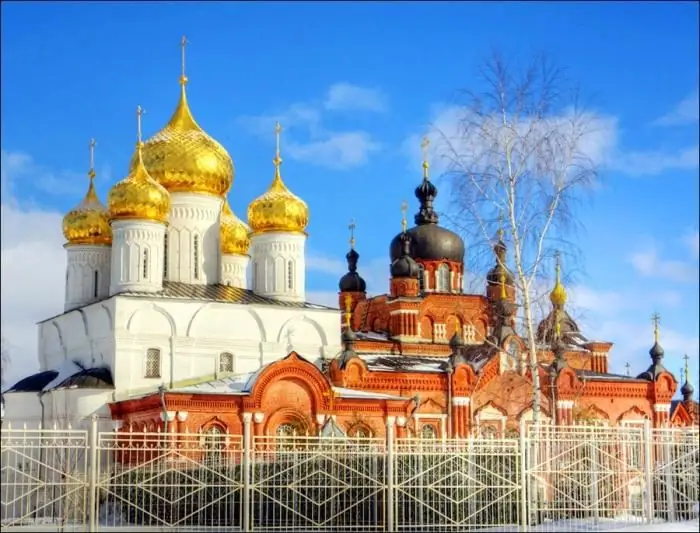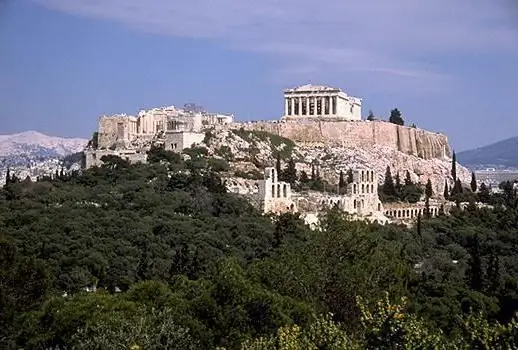- Author Harold Hamphrey [email protected].
- Public 2023-12-17 10:06.
- Last modified 2025-01-24 11:10.
The Basilica of Santa Croce (Florence) - one of the main churches of the city and the largest Franciscan temple in the world, built at the end of the 13th century in the Florentine Gothic style, is famous as the Pantheon of Florence because of the large number of tombs in which they are buried many prominent Italians.

Construction history
According to legend, the founder of Santa Croce is Francis of Assisi (died in 1226), the patron saint of Italy, who abandoned material we alth in order to bring people the ideas of repentance and peace. Although its construction was started in 1295 on the site of a small oratory built by the Franciscans, not far from the Arno River. The name Santa Croce (Florence) is the Church of the Holy Cross in Italian. It was designed by A. di Cambio, a local sculptor and architect. The construction was financed by we althy Florentine families, who considered it an honor to financethe construction of the holy monastery, and lasted almost 150 years. The basilica was consecrated in 1443 by Pope Eugene 4th.
The appearance of the church over the past century has changed more than once. This is especially true of the facade of Santa Croce (Florence): photo from the beginning of the 19th century. shows him completely unadorned. The current appearance of the facade with 3 portals finished with white marble was made only in 1853-1863. architect N. Matas in the neo-Gothic style with the money of English Protestants, in particular the British philanthropist F. J. Sloane. That is why the blue six-pointed Star of David, which is not a symbol of Christianity, appeared in the jewelry.

Florence: Basilica of Santa Croce (photo and description)
The main part of the building is built in the form of a T-shaped cross. Over the past centuries, extensions (chapels) were gradually added to it from all sides. The lower tiers of the basilica are decorated with beautiful arcades, the upper ones - with double-leaf windows. A portico of airy and light arches runs along the left side of the building.
The destruction occurred in the 16th century, in 1512 the old bell tower was broken by lightning, it was only restored by 1847 according to the project of G. Baccani, and now it is a wonderful addition to the main building.

The Basilica of Santa Croce in Florence also includes 3 monasteries, one of which was designed by A. di Cambio. The other, located in the southern part, was designed by Brunneleschi and is considered one of the most beautiful monasteries in Florence. Lesser 3rdthe monastery (13th century) closes the group of extraordinary buildings of the Franciscans.
In front of the Church of Santa Croce on the square there is a statue of Dante, created by the sculptor E. Patzia in 1865. Previously, it was in the center, but then was moved due to mass events closer to the building.
Santa Croce interiors
The inner part consists of a huge monumental space 115 m long, made using unique design solutions. This is especially evident in the design of the central nave, separated from the two side pylons by vertical pylons of octagonal section, from which pointed arches are directed upwards.
At that time, the decision of the interior of the basilica was bold and unconventional, allowing it to stand out from the background of other religious buildings in the city. Light enters through the mosaic windows made by A. Gaddi.

In the 16th c. the church was replanned, because of which (according to the conclusion of experts) it lost its beauty a little. Ceilings are made of truss type, and tombstones are located in the floor, occupying almost the entire space of the nave.
Church altar and frescoes
The frescoes decorating the walls near the main altar were made by A. Gaddi (1387) based on the legend of the True Cross. On the right side: Archangel Michael passes a branch of the Tree of Knowledge, the Queen of Sheba and her worship of the Tree of the Cross, etc. On the left - St. Helen brings the Holy Cross to Jerusalem, then King Percy takes him away, Byzantine King Heraclius returns the Cross toJerusalem, etc. The frescoes also contain many everyday and fairy-tale scenes. The most beautiful antique stained-glass windows on the windows were made in the 14th century.

The altar polyptych, painted by N. Gerini, depicts the Madonna and Child, the side panels were made by other artists, in the upper part - the “Crucifixion”, painted by the masters of the school of Giotto.
The altar is crowned by one of the unique paintings of the church - "Crucifixion", which was created by the master Cimabue. This large picture (4.5 x 3.9 m), placed on a wooden cross, is considered the most impressive version of the crucifixion. However, in a flood in 1966, the work was so badly damaged that even attempts at restoration could not restore it completely.

Church chapels
Inside the church of Santa Croce (Florence), there are 16 chapels (chapels) in the transepts, each of which is a separate extension. The chapels are decorated with unique frescoes and sculptures from different centuries, which were made by the most famous masters of Italy: Matteo Rosselli, G. Do San Giovanni, Fra Bartolomeo, G. Lee Bondone and his students.

The most famous of them:
- Maggiore Chapel and the fresco "The Legend of the Holy Cross" by A. Gaddi (1380).
- Castellani Chapel with frescoes by A. Gaddi with scenes from the life of the Saints (1385).
- The Baronchelia Chapel with a family tomb and a beggar, painted by T. Gaddi "Madonna", on other walls - motives from the life of the VirginMary.
- The Rinuccini Chapel presents works by Master G. Di Milano depicting the Life of Magdalene and the Virgin Mary (1379).
- The Peruzzi Chapel contains an image of the life of I. Baptist and I. Theologian, painted by the artist Giotto.
- Bardi Chapel - highlights the life of Fr. Assisi (artist Giotto).
- Other chapels (Medici, Tosigny, Pulci, etc.) also keep priceless works of art.

Inside the basilica is the monastery courtyard, from which there are also exits to the chapels. Thus, the Pazzi Chapel, called “a true pearl of the Early Renaissance”, is decorated with the most beautiful works of Brunelleschi (1443), decorated by the famous Italian masters D. da Settignano, L. dela Robbia, J. Da Maiano. In front of the chapel is the pronaos, made up of Corinthian columns. In 1461 it was covered with a small dome.
Pantheon of Santa Croce
The most famous people of Italy and honorary citizens of Florence are buried in the church of Santa Croce (Florence). Some of the graves are true, in which deceased celebrities are buried, while others, called cenotaphs, are tombstones that do not contain human remains.
Santa Croce is considered to be the birthplace of the Renaissance, because. contains a monument-tomb of L. Bruni, an Italian politician, created in 1444 by master B. Rosselino. This monument became the model for future Renaissance works, including the gravestone of C. Marsuppini near the north wall of the church.
The most famous tombstones placedalong the right nave of the southern wall:
Monument-bust of Michelangelo by Master Vasari (1579) and many statues and figures by G. Battista and V. Cioli. Although Michelangelo died in Rome, he bequeathed to be buried in his native city. Fulfilling his order and with the permission of the mayor of Florence, L. Buanarotti stole the body of Michelangelo from Rome and secretly moved him here

- The cenotaph of Dante Alighieri and the statues of the heroes of his works were made by the sculptor Ricci (1829).
- Monument to Machiavelli by Spinacia (1787).
- The tomb of Galileo Galilei, who died in 1642, but due to the ban of the church, was not buried according to Christian customs until 1737. Then his body was transported and placed in the church, the sculptural composition and the bust of Galileo were made by G. Battista Foggini.

- Tombstone of the composer G. Rossini, who glorified Italy with the opera "The Barber of Seville". Nine years after his death in 1868 in Paris, his body was moved from the Père Lachaise cemetery and buried here in Florence.
- Tombstone of historian and diplomat N. Machiavelli.
- Tomb of Joseph Napoleon and his daughter, etc.
In total, almost 300 eminent Italians are buried on the territory of the church, and each tombstone is decorated with sculptures and bas-reliefs.
Interesting facts
One of the attractions of the church is the statue of Poetry, made by the Florentine Pio Fedi in 1883, dedicated to the memory of the poet and playwright J. Battista Nicollini. It is installed aboveheadstone in the Basilica of the Holy Cross.
This figure is very similar to the Statue of Liberty, the work of the outstanding French sculptor Fr. Bartholdi (1887). As is known for certain, Bartholdi lived in Florence in 1870 and was obviously inspired by the work of an Italian sculptor.

The cenotaph of the famous poet Dante (1265-1321), located in the church of Santa Croce (Florence), is of great interest to tourists. The history of the tomb of the poet, who became famous for his "Divine Comedy" and created the modern literary Italian language, has been going on for several hundred years. After the death of the poet, Florence fights with the city of Ravenna for the right to transport and bury his remains, but cannot achieve this. Everything happened in the 14th century. through the fault of the rulers and residents of Florence, who expelled Dante from their city for objectionable statements and oppositional views. The writer moved to Ravenna, where he soon died. When Florence began to ask to give her the ashes of Dante, Ravenna did not agree, and since then the sarcophagus in Santa Croce has been empty.

Santa Croce: location, opening hours, prices
To find the famous basilica, you need to come to Piazza Santa Croce (Florence), where it stands. This square in the old days was a venue for fairs and tournaments, now it has become a venue for festivals, performances and concerts. It also sometimes hosts Florentine football competitions, where players are dressed in ancient costumes and compete according to strict old rules.

In Santa Croce (Florence), the museum-church is open from 9.30 to 17.30 on weekdays and Saturdays, on public holidays - from 14.00 to 17.00.
Church ticket price: EUR 8, discounted tickets for children aged 11-17, students - EUR 4, free entry for children under 11, residents of Florence, disabled people and accompanying people.
Reviews of tourists
Tourists who visit the beautiful church of Santa Croce (Florence) are in for a magnificent and majestic sight: each chapel inside the church is a separate museum representing the works of great artists, each tombstone is a masterpiece of sculptural art. Thoughts and feelings that the famous writer Stendhal expressed when he visited the Basilica: excitement bordering on reverence. Exactly the same impression is produced by this monumental structure on modern people.






